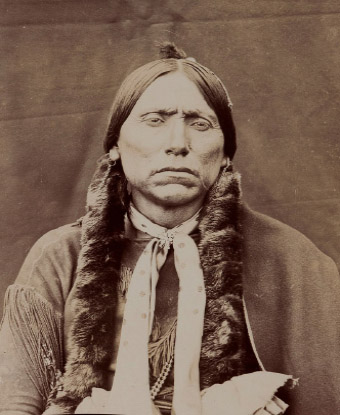Last updated: January 14, 2020
Person
Quanah Parker

Photo/Wikimedia Commons
Quanah Parker was a man of two societies and two centuries: traditional Comanche and white America, 19th century and 20th. He was a respected leader in all of those realms.
Born around 1848 in the Wichita Mountains of Oklahoma, Quanah was the son of Comanche war chief Peta Nocona and his wife Nautda (“Someone Found”), a white woman originally named Cynthia Ann Parker. Cynthia Ann had been kidnapped at age nine during a Comanche raid on her family’s outpost, Fort Parker, located about 40 miles west of present-day Waco, Texas. She grew up as a daughter of the tribe, married Nocona, and gave birth to son Quanah (“Fragrant”), son Pecos (“Peanuts”), and daughter Tot-see-ah (“Prairie Flower”).
The Comanches aggressively repelled trespass onto their domain, known as the Comancheria (today’s Texas, eastern New Mexico, and parts of Kansas and Oklahoma), attacking Texas towns, clashing with the US Army and Texas Rangers, and periodically shutting down traffic on the Santa Fe Trail. Quanah grew to manhood in that environment, the son of a war leader, in a warlike society, during a time of frequent warfare. He was just 11 years old when Texas Rangers carried off Cynthia Ann and little Prairie Flower, igniting in the boy a hatred of white men. (The rangers reported that they killed Peta Nocona in the same attack, but Comanche historians tell that he died years later from old wounds, still grieving the loss of his wife and daughter.) It is not surprising that, by his early 20s, Quanah emerged as a fearsome figure on the Southern Plains, terrorizing traffic along the Santa Fe Trail and raiding hunters’ camps, settlements, ranches, and homesteads across Texas.
Forced to surrender to the US Army in 1875, Quanah settled with his people on a reservation in Oklahoma, assumed his mother’s surname, and began helping the Comanche adjust to their new way of life. Quanah Parker became a strong, pragmatic peacetime leader who helped his people learn to farm, encouraged them to speak English, established a tribal school district for their children, and lobbied Congress on their behalf. Parker welcomed new technology – he bought a car and owned one of the first home telephones in Oklahoma – yet held on to his cultural traditions, refusing to give up any of his eight beautiful wives, his magnificent braids, or his peyote religion. With help from Charles Goodnight and other friendly cattlemen that he once had raided, Quanah Parker became a wealthy rancher and built his stately, two-story Star House at Cache, Oklahoma. There he and his wives fed hungry families who thronged their door, and took in several homeless white boys to be reared with their own two dozen children. Parker also entertained many important guests at his Star House tables, paying a white woman to give his wives cooking lessons and hiring a white woman as a house servant.
Through his hospitality, political activism, and speaking engagements, the one-time war chief emerged as a national celebrity with a reputation for wit, warmth, and generosity. When he died of heart failure in 1911, thousands of mourners, Indian and white, gathered at Star House to pay their respects. Quanah Parker is buried beside his beloved mother, Cynthia Ann, and young sister, Prairie Flower, at Fort Sill, Oklahoma.
The Bank Robbery
Quanah Parker appears in the 1908 silent film, The Bank Robbery, which can be viewed free on YouTube. The near-absence of captions makes it hard to know what’s happening onscreen, and the unsteadiness of the camera and graininess of the film obscure the actors’ facial features. However, Quanah is recognizable late in the film, first at 21:00 minutes (thanks to a caption identifying him as “Juanah Parker”), at 21:27 as one of a group riding toward a Wichita National Forest Game Preserve gateway, and once more at 24:32 during what appears to be a celebration of the capture of the robbers. Wearing a long-sleeved white shirt, a vest, and a high-crowned black hat, Quanah sits tall and straight astride a white horse with a dark spot on its forehead. Watch the entire 25-minute movie to see if you can spot him earlier in the film!
The Saga of Cynthia Ann
Cynthia Ann Parker was about nine years old in 1836 when Comanche and Kiowa raiders attacked her extended family’s settlement, Fort Parker, killing several adults and taking five captives. The other captives were released for ransom over the next six years, but Cynthia was adopted, renamed Nautda, and reared by Comanche parents. She would have been around 20 years old when she became Peta Nocona’s one and only wife and began a family of her own.
Young Quanah grieved when Nautda and his sister, Prairie Flower were captured by Texas Rangers during an attack on his band’s camp at Pease River, Texas, in 1860. He did not realize that Nautda was a white woman and would not learn of his mixed heritage until later in life. After being reunited with the Parker family, Cynthia tried repeatedly to return with her daughter to her husband and sons on the Plains but was caught and returned to her guardians each time. Prairie Flower died of pneumonia in 1864, and unhappy Cynthia Ann starved herself to death in 1871. Quanah and Nautda never met again after her capture, but Quanah took her name, cherished her photograph, and grew friendly with his white relatives. Quanah, Cynthia Ann-Nautda, and Prairie Flower today lie at rest on Chief’s Hill at the Fort Sill Cemetery, where their graves can be visited today.
